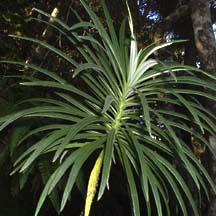
In the Garden![]()
Panaunau
LATIN NAME
Lobelia yuccoides
Description: These shrubs stand 4 feet tall, usually from a single stem that rarely branches. Its narrow leaves are about 1 1/2 feet long, and are dark green on top, with white underneath, forming an attractive tight spiral rosette.
Numerous small blue flowers (40 to 60-plus of them) that look like tiny curved bugles, are arranged on a long stem that rises 1 to 3 feet above the plant. When in bloom, this plant looks amazing!
Distribution: Panaunau is an endemic plant found only in a few mesic ridges and canyons of Kauai and Oahu's Waianae Mountains.
Cultural uses: None are known, but perhaps they were used as bait for catching birds. Sticky sap made from the fruit of Papala kepau (Pisonia spp.) was applied to the base of flowering branches of plants known to attract nectivorous (feeding on nectar) birds. When the bird landed on the branch to feed, it would become stuck to the plant, which made it easier for the kia manu (bird catcher) to retrieve.
Landscape use and care: If you are ever fortunate enough to see this plant available at a sale or store, get it! And if you're quick enough to get it before I do, then you can either leave it in its pot in a semi-shaded area, or you can plant it in the ground in a well-drained, semi-shaded area.
Watch out for spider mites. If you notice them on the plant, wipe them off with your fingers. Keep the soil moist but not too wet. And enjoy.
Note: The appearance of the flower and that of a bird's bill are very similar. This is an example of co-evolution in Hawaii. The bird's curved bill is a perfect fit with the tube leading to the flower's nectar. While feeding, the bird's head brushes up against the pollen, and the bird then becomes a pollinator for the other flowers.
This is a symbiotic relationship because both plant and bird depend on each other for survival. The bird feeds on the plant and the plant needs the bird to reproduce. This co-dependence is seen throughout Hawaii's forests and oceans as well. Native organisms need each other to flourish, so when one species is threatened or goes extinct, the loss can have devastating impact.
Gardening Calendar


